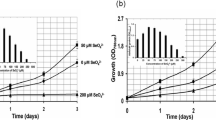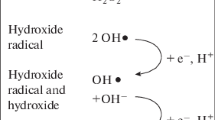Summary
Glutathione peroxidase and glutathione S-transferase both utilize glutathione (GSH) to destroy organic hydroperoxides, and these enzymes are thought to serve an antioxidant function in mammalian cells by catalyzing the destruction of lipid hydroperoxides. Only two groups of procaryotes, the purple bacteria and the cyanobacteria, produce GSH, and we show in the present work that representatives from these two groups (Escherichia coli, Beneckea alginolytica, Rhodospirillum rubrum, Chromatium vinosum, andAnabaena sp. strain 7119) lack significant glutathione peroxidase and glutathione S-transferase activities. This finding, coupled with the general absence of polyunsaturated fatty acids in procaryotes, suggests that GSH-dependent peroxidases evolved in eucaryotes in response to the need to protect against polyunsaturated fatty acid oxidation. A second antioxidant function of GSH is mediated by glutathione thiol-transferase, which catalyzes the reduction of various cellular disulfides by GSH. Two of the five GSH-producing bacteria studied (E. coli andB. alginolytica) produced higher levels of glutathione thiol-transferase than found in rat liver, whereas the activity was absent in the other three species studied. The halobacteria produced γ-glutamylcysteine rather than GSH, and assays for γ-glutamylcysteine-dependent enzymes demonstrated an absence of peroxidase and S-transferase activities but the presence of significant thioltransferase activity. Based upon these results it appears that GSH and γ-glutamylcysteine do not function in bactera as antioxidants directed against organic hydroperoxides but do play a significant, although not universal, role in main-taining disulfides in a reduced state. The function of GSH in the photosynthetic bacteria, aside from providing a form of cysteine resistant toward autoxidation, remains a puzzle, as none of the GSH-dependent enzymes tested other than glutathione reductase were present in these organisms.
Similar content being viewed by others
References
Arnon DI, Das VSR, Anderson JD (1963) Metabolism of photosynthetic bacteria. I. Effect of carbon source and hydrogen gas on biosynthetic patterns ofChromatium. In: Japanese Society of Plant Physiologists (eds) Studies on microalgae and photosynthetic bacteria. University of Tokyo Press, Tokyo, pp 529–545
Arnon DI, McSwain BD, Tsujimoto HY, Wada K (1974) Photochemical activity and components of membrane preparations from blue-green algae. I. Coexistence of two photosystems in relation to chlorophyll a and removal of phycocyanin. Biochim Biophys Acta 357:231–245
Axelsson K, Eriksson S, Mannervik B (1978) Purification and characterization of cytoplasmic thioltransferase (glutathione: disulfide oxidoreductase) from rat liver. Biochemistry 17:2978–2984
Boll M (1969) Glutathione reductase fromRhodospirillum rubrum. Arch Mikrobiol 66:374–388
Chung YC, Hurlbert RE (1975) Purification and properties of the glutathione reductase ofChromatium vinosum. J Bacteriol 123:203–211
De Rosa M, Gambacorta A, Gliozzi A (1986) Structure, biosynthesis, and physicochemical properties of archaebacterial lipids. Microbiol Rev 50:70–80
Eriksson S, Askelöf P, Axelsson K, Carlberg I, Guthenberg C, Mannervik B (1974) Resolution of glutathione-linked enzymes in rat liver and evaluation of their contribution to disulfide reduction via thiol-disulfide interchange. Acta Chem Scand, Ser B 28:922–930
Fahey RC, Newton GL (1983) Occurrence of low molecular weight thiols in biological systems. In: Larsson A, Orrenius S, Holmgren A, Mannervik B (eds) Functions of glutathione: biochemical, physiological, toxicological, and clinical aspects. Raven Press, New York, pp 251–260
Fahey RC, Newton GL, Arrick B, Overdank-Bogart T, Aley SB (1984)Entamoeba histolytica: a eukaryote without glutathione metabolism. Science 224:70–72
Fahey RC, Buschbacher RM, Newton GL (1987) The evolution of glutathione metabolism in phototrophic microorganisms. J Mol Evol 25:81–88
Flohé L (1982) Glutathione peroxidase brought into focus. In: Pryor WA (ed) Free radicals in biol, vol V. Academic Press, New York, pp 223–254
Gan ZR, Wells WW (1987) Preparation of homogeneous pig liver thioltransferase by a thiol: disulfide mediatedpI shift. Anal Biochem 162:265–273
Gleason FK, Holmgren A (1981) Isolation and characterization of thioredoxin from the cyanobacterium,Anabaena sp. J Biol Chem 256:8306–8309
Habig WH, Pabst MJ, Jakoby WB (1974) Glutathione S-transferases: the first enzymatic step in mercapturic acid formation. J Biol Chem 249:7130–7139
Holmgren A (1979a) Glutathione-dependent synthesis of deoxyribonucleotides: purification and characterization of glutaredoxin fromEscherichia coli. J Biol Chem 254:3664–3671
Holmgren A (1979b) Reduction of disulfides by thioredoxin: exceptional reactivity of insulin and suggested functions of thioredoxin in mechanism of hormone action. J Biol Chem 254:9113–9119
Holmgren A (1985) Glutaredoxin fromEscherichia coli and calf thymus. Methods Enzymol 113:525–540
Horecker BL, Kornberg A (1984) The extinction coefficients of the reduced band of pyridine nucleotides. J Biol Chem 175: 385–390
Jakoby WB, Habig WH (1980) Glutathione transferases. In: Jakoby WB (ed) Enzymatic basis of detoxication, vol II. Academic Press, New York, pp 63–94
Johnson TC, Crawford NA, Buchanan BB (1984) Thioredoxin system of the photosynthetic anaerobeChromatium vinosum. J Bacteriol 158:1061–1069
Johnson TC, Yee BC, Carlson DE, Buchanan BB, Johnson RS, Mathews WR, Biemann K (1988) Thioredoxin fromRhodospirillum rubrum: primary structure and relation to thioredoxin from other photosynthetic bacteria. J Bacteriol 170: 2406–2408
Larson K, Eriksson V, Mannervik B (1985) Thioltgransferase from human placenta. Methods Enzymol 113:520–524
Lau EP, Niswander L, Watson D, Fall RR (1980) Glutathione-S-transferase is present in a variety of microorganisms. Chemosphere 9:565–569
Lowry OH, Rosebrough NJ, Farr AL, Randall RJ (1951) Protein measurement with the Folin phenol reagent. J Biol Chem 193:265–275
Mannervik B (1980) Thioltransferases. In: Jakoby WB (ed) Enzymatic basis of detoxication, vol II. Academic Press, New York, pp 229–244
Mannervik B (1985a) The isoenzymes of glutathione transferase. Adv Enzymol 57:357–417
Mannervik B (1985b) Glutathione peroxidase. Methods Enzymol 113:490–495
Margulis L (1970) Origin of eukaryotic cells. Yale University Press, New Haven, pp 122, 178
Margulis L (1981) Symbiosis in cell evolution, WH Freeman, San Francisco
Mata AM, Pinto MC (1984) Purification by affinity chromatography of glutathione reductase (EC 1.6.4.2) fromEscherichia coli and characterization of such enzyme. Z Naturforsch 39c:908–915
Meijer J, DePierre JW, Rannug U (1980) Measurement of drugmetabolizing systems inSalmonella typhimurium strains G46, TA1538, TA100, and TA98. Chem-Biol Interact 31:247–254
Mevarech M, Leicht W, Werber MM (1976) Hydrophobic chromatography and fractionation of enzymes from extremely halophilic bacteria usiong decreasing concentration gradients of ammonium sulfate. Biochemistry 15:2382–2387
Moron MS, DePierre JW, Mannervik B (1979) Levels of glutathione, glutathione reductase and glutathioneS-transferase in rat lung and liver. Biochim Biophys Acta 582:67–78
Nadler V, Goldberg I, Hochman A (1985) Comparative study of bacterial catalases. Biochim Biophys Acta 882:234–241
Nagai S, Black S (1968) A thiol-disulfide transhydrogenase from yeast. J Biol Chem 243:1942–1947
Nakamura W, Hosoda S, Hayashi K (1974) Purification and properties of rat liver glutathione peroxidase. Biochim Biophys Acta 358:251–261
Newton GL, Fahey RC (1989) Glutathione in porocaryotes. In: Viña J (ed) Handbook of glutathione: metabolism and physiological functions, CRC Press, Boca Raton (in press)
Newton GL, Javor B (1985) γ-glutamylcysteine and thiosulfate are the major low-molecular-weight thiols in halobacteria. J Bacteriol 161:438–441
Ormerod JG, Ormerod KS, Gest H (1961) Light-dependent utilization of organic compounds and photoproduction of molecular hydrogen by photosynthetic bacteria; relationships with nitrogen metabolism. Arch Biochem Biophys 94:449–463
Paglia DE, Valentine WN (1967) Studies on the quantitative and qualitative characterization of erythrocyte glutathione peroxidase. J Lab Clin Med 70:158–169
Segel IH, Johnson MJ (1963) Synthesis and characterization of sodium cysteine-S-sulfate monohydrate. Anal Biochem 5:330–337
Serrano A, Rivas J, Losada M (1984) Purification and properties of glutathione reductase from the cyanobacteriumAnabaena sp. strain 7119. J Bacteriol 158:317–324
Setlow B, Setlow P (1977) Levels of acetyl coenzyme A, reduced and oxidized coenzyme A, and coenzyme A in disulfide linkage to protein in dormant and germinated spores and growing and sporulating cells ofBacillus megaterium. J Bacteriol 132: 444–452
Shishido T (1981) Glutathione S-transferase fromEscherichia coli. Agric Biol Chem 45:2951–2953
Smith J, Shrift A (1978) Phylogenetic distribution of glutathione peroxidase. Comp Biochem Physiol 63B:39–44
Summer KH, Göggelmann W, Greim H (1980) Glutathione and glutathione S-transferase in the salmonella mammalian-microsome mutagenicity test. Mutat Res 70:269–278
Sundquist AR, Fahey RC (1988) The novel disulfide reductase bis-γ-glutamylcystine reductase and dihydrolipoamide dehydrogenase fromHalobacterium halobium: purification by immobilized-metal-ion affinity chromatography and properties of the enzymes. J Bacteriol 170:3459–3467
Sundquist AR, Fahey RC (1989) The function of γ-glutamyl-cysteine and bis-γ-glutamylcystine reductase inHalobacterium halobium. J Biol Chem 264:719–725
Swerdlow RD, Setlow P (1983) Purification and characterization of aBacillus megaterium disulfide reductase specific for disulfides containing pantethine 4′,4″-diphosphate. J Bacteriol 153:475–484
Tel-Or E, Huflejt ME, Packer L (1986) Hydroperoxide metabolism in cyanobacteria. Arch Biochem Biophys 246:396–402
Villanueva E, Luehrsen KR, Gibson J, Delihas N, Fox GE (1985) Phylogenetic origins of the plant mitochondrion based on a comparative analysis of 5S ribosomal RNA sequences. J Mol Evol 22:46–52
Williams CH (1976) Flavin-containing dehydrogenases. In: Boyer PD (ed) The enzymes, ed 3, vol XIII. Academic Press, New York, pp 39–44
Yang D, Oyaizu Y, Oyaizu H, Olsen GJ, Woese CR (1985) Mitochondrial origins. Proc Natl Acad Sci USA 82:4443–4447
Author information
Authors and Affiliations
Rights and permissions
About this article
Cite this article
Sundquist, A.R., Fahey, R.C. Evolution of antioxidant mechanisms: Thiol-Dependent peroxidases and thioltransferase among procaryotes. J Mol Evol 29, 429–435 (1989). https://doi.org/10.1007/BF02602913
Received:
Revised:
Accepted:
Issue Date:
DOI: https://doi.org/10.1007/BF02602913




